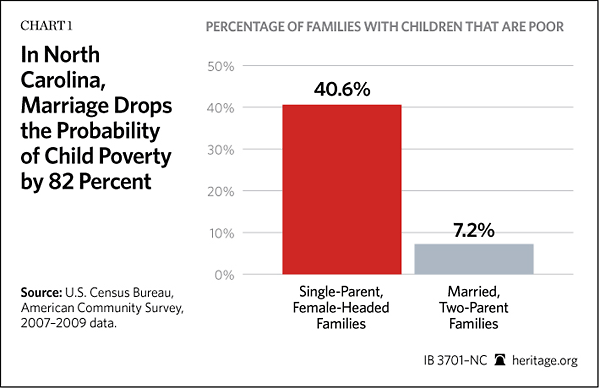Robert Rector of the Heritage Foundation offers the following thoughts about the links between marriage and alleviation of poverty:
The continuing collapse of marriage in America, along with a dramatic rise in births to single women, is the most important cause of childhood poverty. In North Carolina, for example, seven of every 10 poor families with children are headed by a single parent — most of them mothers.
Only 7 percent of married couples with children in North Carolina were poor in 2009, compared with 40.6 percent of single-parent families. In North Carolina, marriage drops the probability of a child’s living in poverty by 82 percent.
Such state numbers on marriage and poverty mirror the national ones. Ignoring the positive impact of marriage on children leads to faulty government policies. It’s tragic, really.
After the U.S. Census Bureau releases its annual poverty report Sept.12, we’ll hear that about one in five American children are poor. Clearly the current recession with its high unemployment pushed up these numbers. But the fact is the child poverty rate was high before the recession and will remain so after it ends.
In 2010, four of every 10 children born in North Carolina were born outside marriage. Sadly, the women most likely to have children without being married are those with the least ability to support children financially on their own. Nearly two-thirds of births to women who are high school dropouts (65 percent) occur outside marriage. Among women who are college graduates, only 8 percent of births are out of wedlock
America is splitting into two economic castes: In the top, children are raised by married couples with a college education. In the bottom, children are raised by single mothers with a high school diploma or less.
Policymakers at the state and national level, of course, know that education reduces poverty. But they’re largely unaware that marriage is an equally strong anti-poverty weapon. Remarkably, being married is as strong a factor in reducing poverty as graduating from high school. In North Carolina, married couples with children are 76 percent less likely to be poor than single-parent families with the same level of education.
The nation wisely spends billions of dollars a year to educate low-income children, and billions more for means-tested welfare aid for single mothers. But, despite the massive impact of marriage in reducing poverty, government does little or nothing to discourage births outside marriage — and nothing to encourage healthy marriages.
Many common misconceptions persist. This isn’t about teen pregnancy: Most non-marital births occur to women in their early 20s. Girls under 18 account for only about eight of every 100 births outside marriage. Also, lack of access to birth control isn’t a significant factor.
Some claim unmarried fathers just aren’t “marriageable.” In fact, the overwhelming majority are. These fathers have jobs and, on average, have higher earnings than the mothers. If they remained in the home, child poverty would drop dramatically.
Are low-income single mothers hostile to marriage? No. Research shows most look quite favorably on the institution. They simply don’t see marriage as something that should come before the baby carriage. The result is sustained high levels of child poverty and a host of related social problems.
We need to develop new policies that build on these positive attitudes about marriage. Policymakers and ordinary citizens, looking at these numbers, should demand that government provide facts about the value of marriage to at-risk youth.
For instance, government ought to connect low-income couples with community resources to help them learn, or relearn, skills needed to build and sustain healthy marriages — before they bring children into the world.
It’s also imperative to reform the welfare system to encourage rather than penalize marriage.
Just as government discourages young people from doing drugs or dropping out of school, it should expose the severe shortcomings of the “child first, marriage later” philosophy — especially in low-income communities. Then we will begin to lift millions of children out of poverty.
You’ll find more detail in a new Heritage report.



